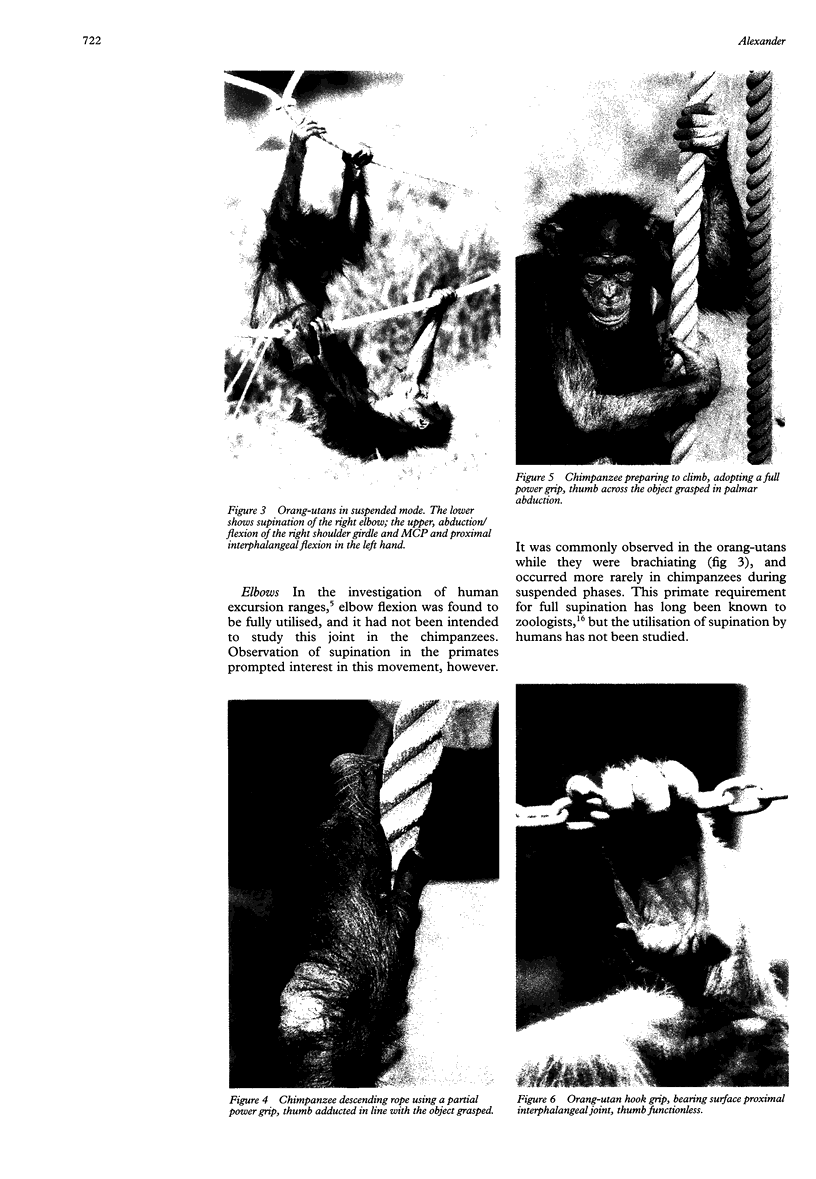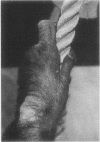Abstract
OBJECTIVE--To determine whether an arboreal lifestyle required full use of movement ranges underutilised in nine joint groups in humans, because under-utilisation of available movement range may be associated with susceptibility to primary osteoarthritis. METHODS--Utilisation of the nine joint groups was studied in two species of primate exercising in a simulated arboreal environment, using 'focal animal' observation techniques supplemented by telephoto photography and by review of archival material from other sources. Fifteen apes were observed over a total observation period of 20.2 man-hours and 152 films were analysed for utilisation of movement range. RESULTS--With one exception, all the movement ranges reported to be under-utilised in humans were fully utilised by the apes in climbing activities. The exception, metacarpophalangeal extension, was an essential component of the chimpanzee ground progression mode of knuckle walking. CONCLUSIONS--The underused movement range in several human joints is explicable as residual capacity from a semiarboreal lifestyle. If the correlation with primary osteoarthritis is confirmed, it suggests that the disease may reflect a disparity between inherited capacity and current need. The significance of the result lies in its implication that primary osteoarthritis may be preventable.
Full text
PDF





Images in this article
Selected References
These references are in PubMed. This may not be the complete list of references from this article.
- Agunwa W. C. Low incidence of osteoarthrosis of the hips in contrast with osteoarthrosis of the knees among rural Saudis: why? Ann Rheum Dis. 1989 Apr;48(4):351–352. [PMC free article] [PubMed] [Google Scholar]
- Alexander C. J., Hochstein B. E. Osteoarthritis of the metacarpophalangeal joints: the relation between ray prevalence, trauma, and utilisation. Skeletal Radiol. 1993;22(1):25–31. doi: 10.1007/BF00191521. [DOI] [PubMed] [Google Scholar]
- Alexander C. J. Relationship between the utilisation profile of individual joints and their susceptibility to primary osteoarthritis. Skeletal Radiol. 1989;18(3):199–205. doi: 10.1007/BF00360971. [DOI] [PubMed] [Google Scholar]
- Alexander C. Flexion angles of the knee in different resting positions and their relation to the prevalence of osteoarthritis. J Rheumatol. 1991 Aug;18(8):1223–1226. [PubMed] [Google Scholar]
- Altmann J. Observational study of behavior: sampling methods. Behaviour. 1974;49(3):227–267. doi: 10.1163/156853974x00534. [DOI] [PubMed] [Google Scholar]
- Bremner J. M., Lawrence J. S., Miall W. E. Degenerative joint disease in a Jamaican rural population. Ann Rheum Dis. 1968 Jul;27(4):326–332. doi: 10.1136/ard.27.4.326. [DOI] [PMC free article] [PubMed] [Google Scholar]
- Bullough P., Goodfellow J., O'Conner J. The relationship between degenerative changes and load-bearing in the human hip. J Bone Joint Surg Br. 1973 Nov;55(4):746–758. [PubMed] [Google Scholar]
- Goodfellow J. W., Bullough P. G. The pattern of ageing of the articular cartilage of the elbow joint. J Bone Joint Surg Br. 1967 Feb;49(1):175–181. [PubMed] [Google Scholar]
- Gunn D. R. Don't sit--squat! Clin Orthop Relat Res. 1974;(103):104–105. doi: 10.1097/00003086-197409000-00067. [DOI] [PubMed] [Google Scholar]
- HARRISON M. H., SCHAJOWICZ F., TRUETA J. Osteoarthritis of the hip: a study of the nature and evolution of the disease. J Bone Joint Surg Br. 1953 Nov;35-B(4):598–626. doi: 10.1302/0301-620X.35B4.598. [DOI] [PubMed] [Google Scholar]
- Hoaglund F. T., Yau A. C., Wong W. L. Osteoarthritis of the hip and other joints in southern Chinese in Hong Kong. J Bone Joint Surg Am. 1973 Apr;55(3):545–557. [PubMed] [Google Scholar]
- Hutton C. W. Generalised osteoarthritis: an evolutionary problem? Lancet. 1987 Jun 27;1(8548):1463–1465. doi: 10.1016/s0140-6736(87)92209-4. [DOI] [PubMed] [Google Scholar]
- Jurmain R. Trauma, degenerative disease, and other pathologies among the Gombe chimpanzees. Am J Phys Anthropol. 1989 Oct;80(2):229–237. doi: 10.1002/ajpa.1330800211. [DOI] [PubMed] [Google Scholar]
- Lovejoy C. O. The origin of man. Science. 1981 Jan 23;211(4480):341–350. doi: 10.1126/science.211.4480.341. [DOI] [PubMed] [Google Scholar]
- Mikkelsen O. A. Knuckle pads in Dupuytren's disease. Hand. 1977 Oct;9(3):301–305. doi: 10.1016/s0072-968x(77)80121-6. [DOI] [PubMed] [Google Scholar]
- Rothschild B. M., Woods R. J. Osteoarthritis, calcium pyrophosphate deposition disease, and osseous infection in Old World primates. Am J Phys Anthropol. 1992 Mar;87(3):341–347. doi: 10.1002/ajpa.1330870308. [DOI] [PubMed] [Google Scholar]
- Solomon L., Beighton P., Lawrence J. S. Rheumatic disorders in the South African Negro. Part II. Osteo-arthrosis. S Afr Med J. 1975 Oct 4;49(42):1737–1740. [PubMed] [Google Scholar]
- Tuttle R. H. Knuckle-walking and the problem of human origins. Science. 1969 Nov 21;166(3908):953–961. doi: 10.1126/science.166.3908.953. [DOI] [PubMed] [Google Scholar]











